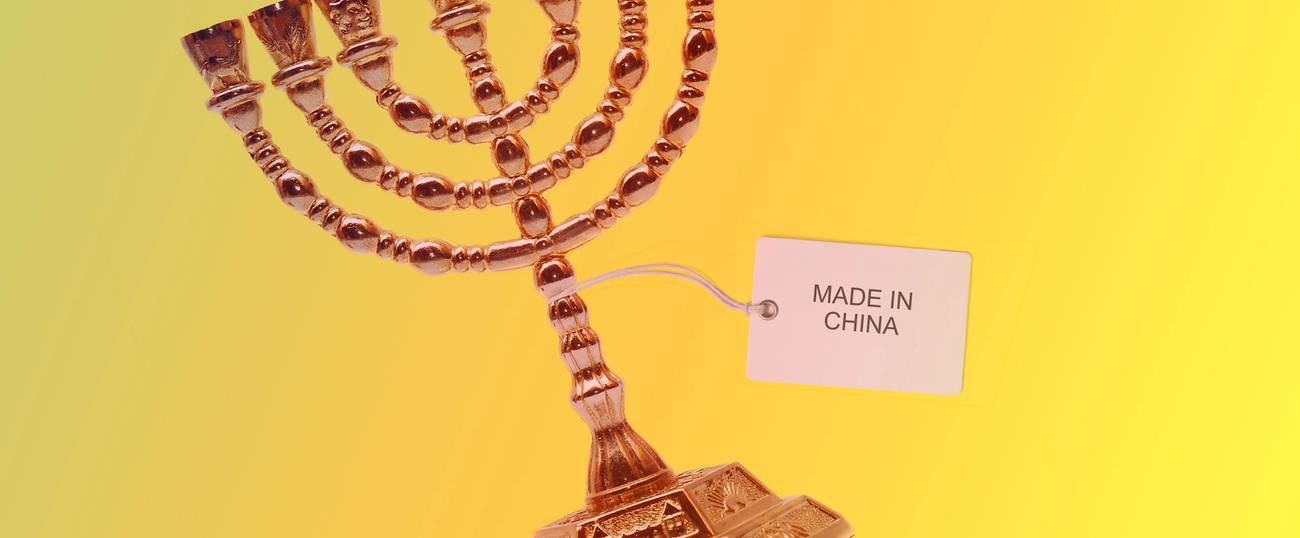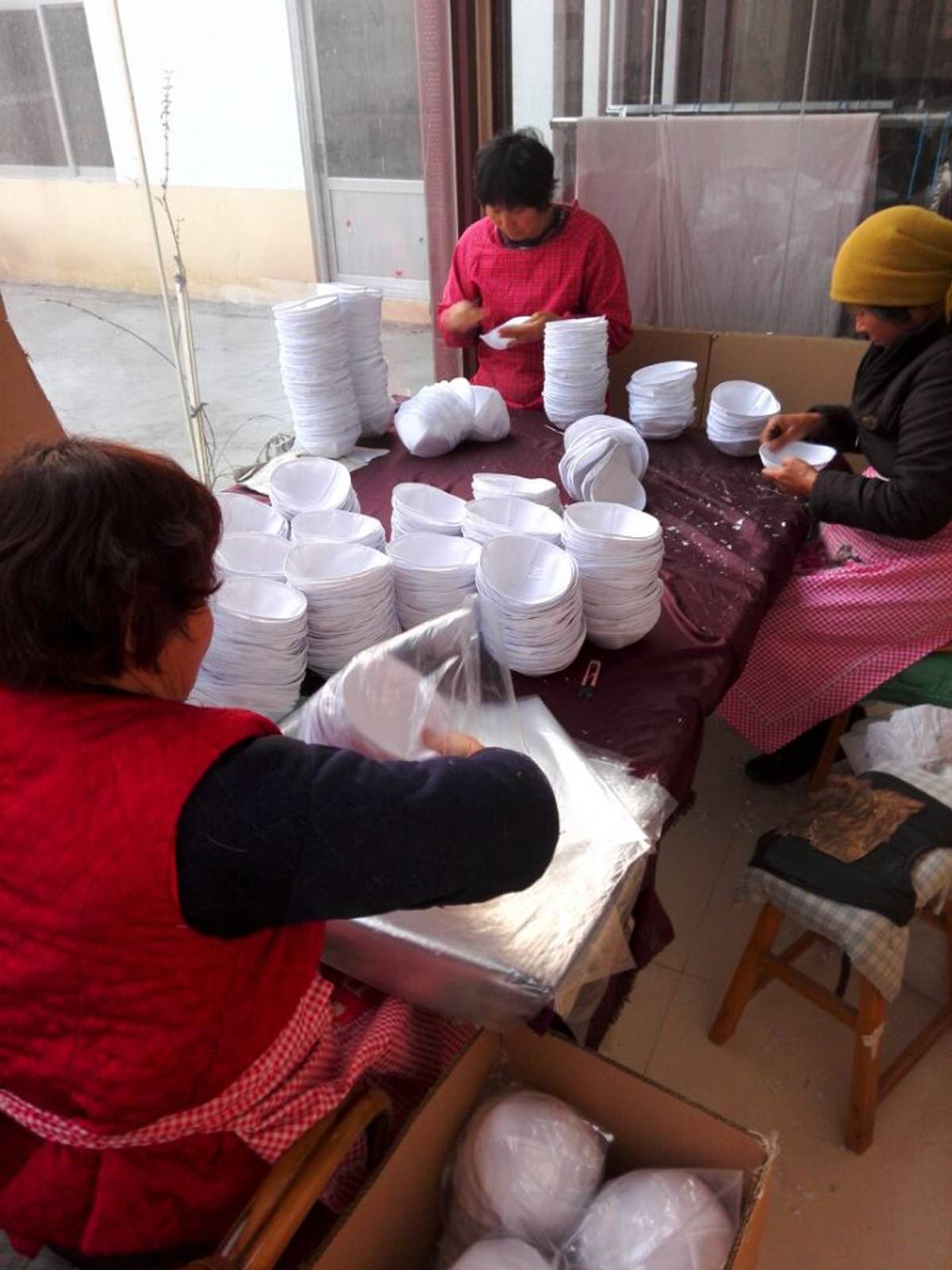China Dolls
Most of the world’s Judaica isn’t made by Jews. Much of it comes from the Far East. Should we care?




I learned about Chinese Judaica because of a $25 billion IPO. This was in September 2014, when the financials were abuzz with Alibaba’s impending public offering, which turned out to be the world’s largest. Alibaba is a massive Chinese e-commerce platform; its website, which looks a lot like eBay, is essentially the front page of the East Asian manufacturing sector.
Everything, I knew, was made in China. That probably included Judaica. When news of the IPO brought me to Alibaba, on a whim I typed “kippah” into the search bar. Up popped a page full of kippahs: suede, leather, knitted. Among them one style stood out: It was knitted, two shades of brown in a swirl pattern, and I was wearing it on my head at that moment. The minimum order was 1,000 units; the supply ability was 30,000 units a month. The company was called Ever Better.
It was past midnight on the East Coast but mid-afternoon in China. Ever Better had a phone number—why not call and ask about ordering 100 duplicates of the kippah I was wearing?
“Hi, does your company make kippahs?” It had taken a while to be transferred to someone who spoke a little English.
Yes, said the man on the other end.
“How many different kinds does your company make?”
He laughed. “Many, many. Which material do you want? Satin, velvet, or knit?” He explained how price could differ by style, by thickness of thread, by whether the kippah was made by hand or machine. He knew the nuances of the various designs better than I did.
Then he asked, “Where are you?”
“I’m in the United States. Philadelphia.”
“United States,” he said approvingly. “It’s a big market.”
***
This is how I began investigating the scope of the Chinese Judaica market. Its role is somewhat hidden by imperfect labeling practices and Israeli middlemen. Even some Judaica retailers I spoke to weren’t fully aware of their products’ origins.
To understand the market, I needed to talk to the distributors and importers. In October, I ended up on the phone with one Alex Rosenthal, the president of Rite Lite, one of America’s largest distributors of Judaica. Like many sellers of Jewish ritual objects, Rite Lite was literally a mom-and-pop operation, established by Rosenthal’s parents in 1949. Once upon a time, such a business meant staying in touch with a network of Jewish craftsmen, skilled in making everything from candlesticks to dreidels, But Rosenthal’s principal business travel for the past 15 years has been to China.

Rosenthal suspects he’s purchased close to a million menorahs in his life—a mere fraction of them made in the United States. American mass production of Judaica has all but evaporated, Rosenthal told me. It was long ago eclipsed by lower prices overseas, first in India and now in China. These two countries have a lock on “low-end” Judaica, which Rosenthal defines as items retailing for $75 or less. If an object isn’t handcrafted and it isn’t one of the few objects that Jewish law specifically mandates be made by Jews, it’s probably from East Asia.
How much of “low-end” Judaica in America is produced in those countries? According to Rosenthal, three out of every four pieces of Judaica sold in America. Another Judaica distributor told me the number was closer to nine in 10. In other words: Unless that mezuzah case you bought was particularly fancy, it was likely made on the other side of the world.
The history of Rite Lite is the history of the American Judaica market. Rosenthal’s company is now mainly an importer, but it began as a manufacturer, starting with the “Rite Lite” itself, a spring-loaded candle holder designed to keep a Shabbat candle flame at constant height while it burned.
Rosenthal’s parents were Holocaust survivors, and they based the candle holder on something they had seen in Europe. Jacob Rosenthal’s first job in the United States was as a lumber merchant, but the Judaica business was a way to make a living without having to work on Saturdays. The company website tells the next part of the story: “One fateful day, Mr. Rosenthal took his idea to the Lower East Side workshop of a man equipped to turn his dream into a reality. There he found Murray Zuckerman producing menorahs; the rest, as they say, is history.”
History is funny, though. Today, 90 percent of Rite Lite’s menorahs are made in China. When asked about the shift, the younger Rosenthal was unsentimental. “You can’t live in the past,” he told me. It’s admirable to support local business, but market forces rule the day. He compared it to the rise of machine-made matzo. When the machines were invented, there were initially protests, and many 19th-century rabbis condemned their use. Then the machines won. “Nothing stands in the way of progress.”
Of course, not all Judaica can be exported. The chief obstacle is Jewish law, which mandates that certain objects—especially Torah scrolls, tefillin, and the parchment inside the mezuzah—be made by Jews. (Tallit and tzitzit are in this category, too, but only the strings, not the garment itself; the way the disparity between the two affects tallit production and taxation is a story for a different time.) Kippot can theoretically be made by anyone, but some manufacturing has stayed in America for a different reason: logistics. If you need to order 100 customized kippot for a bar mitzvah, there’s no time to get them from China; even if you did, your order would be too small to be worth filling. These quirks keep four or five American kippah makers, all in the New York area, in business.
Jeremy Lowy is one of those who remain. Founder of J. Lowy Skullcap, he’s been in the kippah business for 40 years. Lowy and another manufacturer told me that virtually all of their orders are for customized designs. The business isn’t just weddings and bar mitzvahs, either—surprisingly, it’s common for political campaigns to order kippot for their supporters, too. In 2008, Lowy filled an order for Barack Obama (suede, gray, with the campaign logo). This year, he’s worked for Hillary Clinton and Bernie Sanders (suede, blue), and Donald Trump (suede, red). All three feature the candidates’ names in Hebrew and English; if you didn’t know better, you’d think they were souvenirs from a bar or bat mitzvah.
Lowy pointed out something that hadn’t occurred to me: Custom kippahs are far more profitable than the standard fare, because the former are bought in bulk and are usually tossed, while the latter are bought one at a time and worn forever. China’s role is small here because the market for daily kippah-wearers is eclipsed by the people who throw them away.
Business is fine for now, but the market is shrinking. Every Jewish event used to come with a custom kippah; today, not so much, and there are only so many Jews and political candidates.
Lowy does have a dream, though: “If I can get the pope to get all Catholics to wear kippahs, now we’re talking. Now we have a market.”
A year after I first called China to inquire about kippah-making there, I called again, this time with the aid of a phone translator. I was able to confirm what I already suspected and what Judaica merchants had told me repeatedly: The people working in Chinese factories knew everything about the kippah market but almost zero about what they were making. “I think it’s for weddings?” one woman told me.
The Chinese indifference to the meaning of the Judaica they make is, to me, breathtaking. Both manufacturers and distributors told me that the Chinese do not care one whit about the meaning of the Judaica they construct. No Chinese firm specializes in Judaica at all; objects get made all over the place, always alongside a dozen other unrelated product lines. In Qingdao, Ever Fortune makes kippot alongside baseball caps, winter hats, and hundreds of other kinds of headgear. In Yiwu, Shangrao Knit Crochet Craft Factory makes challah covers, kiddush cups, and crotched kippot alongside Muslim headgear, baby bibs, and hammocks. Hangzhouse Bodenda Tin Co. mainly manufactures small metal containers, but they will sell you menorahs if you order at least 10,000, or enough for every Jewish family in Cincinnati.
***
With China as the manufacturer, the gap between the maker and the user couldn’t be larger. Chinese Judaica represents the intersection of the minuscule and the massive. In 1967, Milton Himmelfarb wrote, “The number of Jews in the world is smaller than a statistical error in the Chinese census.” Today, it would be accurate to say that Judaica market is no more than a statistical error in China’s GDP.
Rosenthal put it more poetically. “We’re a wart on the backside of mankind.”
In China, Jewish culture has always been a little lost: Its prophets did not see Moses as their predecessor, its faiths did not need to supersede Sinai, there are no faint echoes of the aleph and the bet in its logographs. Jews have lived in China for centuries, but they give further proof of the space between the cultures. A Haggadah from Kaifeng skips the blessing on matzo. The scholar David Stern suggests that the nuance of unleavened bread was probably lost in a land where the key staple was rice and even leavened bread was rare.
In the course of my research, every Judaica dealer I spoke with asked me the same question: Why do you care where your kippahs are made? Rosenthal said about buying Judaica, “It’s not a religious experience, unless you call bargains a Jewish trait.” Why should the origins of a tallit bag matter any more than the origins of an iPhone?
The answer, I think, is that everybody thinks about iPhone in basically the same way, whereas nobody who makes menorahs thinks much about them at all, except for the end user. My anxiety around Chinese Judaica stems from the fact that the material artifacts of faith—the mezuzah on the door, the menorah on the mantle, the candlesticks on the bureau—are not just artifacts of faith because they exist in another context as well, and in that context a menorah is just another product line that happens to sell well in America.
At the point of sale, a menorah has two histories. In one, it is linked to its seven-branched Temple prototype, and Maccabean revolt, and the story of the miracle of the oil. In the other, it is a specialty tin can. One history is sacred, the other profane—the menorah has no opinion on the matter. For me, being
aware of Chinese Judaica means being aware of the fragility of holiness, of our power to choose not only which history to prioritize but to add ourselves to that very history, imbuing those objects with memories of our own.
***
Like this article? Sign up for our Daily Digest to get Tablet Magazine’s new content in your inbox each morning.
David Zvi Kalman is a Fellow in Residence at the Shalom Hartman Institute and the founder of an independent Jewish publishing house.